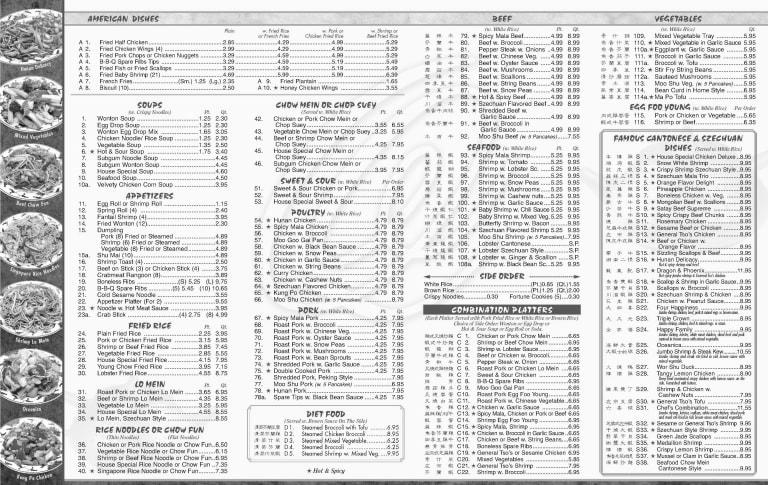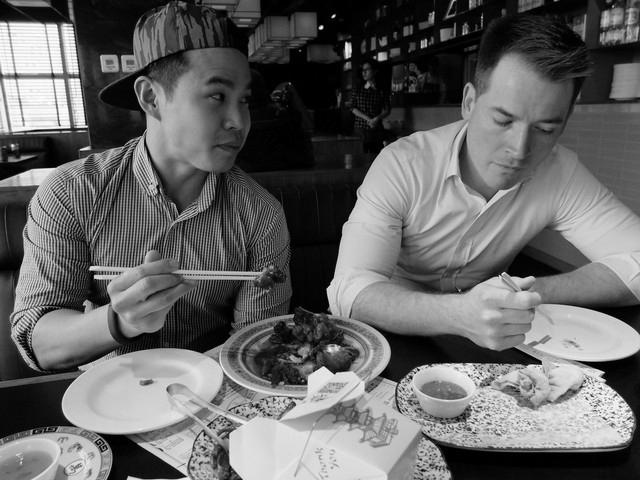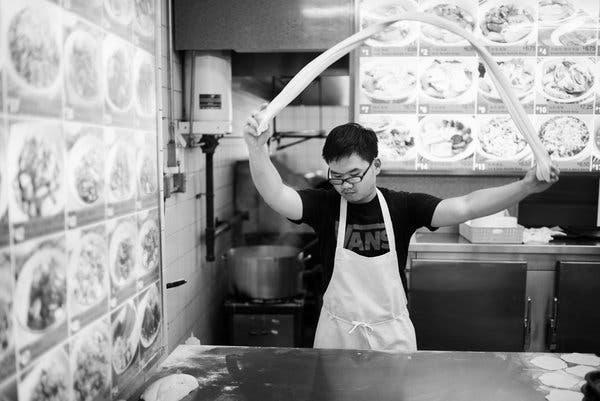In the old days, Chinese restaurants only advertised in their native language. The menu would be restricted to what the Chinese speak, and Americans would be content eating fried rice, egg rolls, and General Tso’s chicken. That is not the case anymore. Nowadays, the menus can vary depending on the region you’re in.
Cantonese restaurants have sweet-and-sour dishes.
If you’re looking for a classic Chinese dish, you should look no further than Cantonese restaurants. These establishments serve authentic Cantonese dishes, but their recipes often incorporate flavors from provinces such as Hunan and Sichuan. Usually, this adaptation is necessary to accommodate the tastes of the locals. For example, the deep-fried cashew chicken available in most Cantonese restaurants came about after a Springfield, Missouri, a restaurant could not attract the locals with its Cantonese seafood dishes.
A sweet-and-sour dish is one of the most popular dishes in westernized Cantonese cuisine. The sauce can be found in many forms and may be available in different regions. In China, the sauce is produced in several provinces but is most common in Jiangsu. It’s also found in many western dishes, from barbecue to salads.
A sweet-and-sour dish is a classic Chinese dish that is excellent for any occasion. When making it, be sure to prepare the ingredients ahead of time. This includes dicing, marinating, and preparing the word in a small bowl. Then, the ingredients should be cooked quickly and over high heat to seal their natural vitamins and minerals.
Sichuan restaurants have spicy food.
If you’ve never eaten Sichuan food, you’re in for a treat. Sichuan cuisine has a reputation for being refreshing and delicious. This region of China is often referred to as the Italy of China. But if you don’t want to get too hot, try the food at Sichuan restaurants.

Elmhurst’s premiere Sichuan restaurant features a menu with plenty of green and dried chiles. Among the menu, dishes are the rolling stone beef and Mao Xue Wang, meat soaked in duck blood. Other specialties include sliced lamb with fresh chili sauce and organ meats.
Although Sichuan is famous for spicy food, it wasn’t until 300 years ago that the chili pepper made its way to the region. The pepper, originally from Latin America, laid the foundation for modern Sichuan cuisine. Before the chili pepper, Sichuan people used different spices such as dogwood and ginger. They believed that the heat from these spices would help them get rid of their body’s humidity.
Sichuan food uses a heavy amount of salt. The region was historically the center of salt production in China. It supplied nearly one-third of the salt used in the country. Salt is used heavily in Sichuan dishes to keep the words fresh. It’s also used to flavor vegetables fermented in salty sauces. In addition, old broad beans and chili are used to make pixian douban, which is a spicy hot pot.
While Sichuan food is traditionally spicy, many people enjoy it. It is a great way to bond with family and friends. Sichuan hotpot has become an international sensation. There are even giant hotpot chains based on the Sichuan hotpot. This growth is mainly due to a growing awareness of the region’s food culture and spicy cuisine.
Shangdong restaurants have salty and crispy food.
Shandong restaurants are known for their salty and crispy food. The signature dish is crispy chicken. It is made with fresh ingredients and has excellent flavor and aroma. If you are looking for a vegetarian dish, try tofu, fungi, or local vegetables. They all have unique tastes. Initially, the Qufu area was home to a Confucian residence, and the Confucian style emphasized the heat and essence of the food. Chefs in the region pay close attention to the taste of the meat and vegetables.

Shandong restaurants also have a distinct flavor. They use a cooking technique called braising to prepare their food. This method involves boiling the ingredients and simmering them for hours. This results in a thick sauce that stays soft in the mouth. You can try braised meat and vegetables, including tofu. Many Shandong restaurants feature this particular type of food.
A Shandong restaurant is an excellent choice for a fine dining experience in the Lixia district. The restaurant has a relaxed dining atmosphere and offers quality service. The menu includes Shandong-style dishes like scalloped pork kidneys and pig’s large intestines braised in soy sauce. You can also try dumplings filled with shrimp meat. Other specialties include dough drop soup, fried crap with sweet and sour sauce, and egg yolk pastry.
Traditional Shandong cuisine is rich in salt and vinegar. It is one of the oldest culinary regions in China and is renowned for its delicious seafood. The Shandong region was once a major cultural center and early modernization. Its cuisine set the standard for the rest of the country. The province has a long coastline, so fresh river fish has always been a delicacy. It also has an abundance of vegetable dishes and emphasizes the use of high heat to lock in flavors.
Hunan Style Braised Pork
Featuring a unique blend of regional flavors, Hunan Style Braised Pork is a must-try on your next trip to China. Most of the ingredients are local and are produced by domestic agricultural producers. While the dish may sound complicated, it is easy to make.
The pork belly is slow-cooked until it is tender and coated in a sweet and spicy sauce. Hunan-style braised pork is made with a thick, sweet, and sticky sauce. It has a melt-in-your-mouth texture and is served with steamed white rice. In addition to the Shanghai-style braised pork belly, you can also find versions from other regions of China.

A quick Chinese stir-fry, Hunan pork is a favorite among locals. It originates in Hunan province and is known as Xiao Chao Rou or «small stir-fried pork.» The pork is stir-fried and seasoned with chili pepper, Chinese spicing, and fermented black beans. It has a spicy, peppery flavor and is very easy to make. This dish is a classic in Hunan kitchens.
Hunan Style Braised Pork is one of the most popular dishes at Hunan Garden in Clovis. The pork is served with plain steamed rice or stir-fried vegetables. It is filled with a smothering sauce and onion and costs just $9.99. The only dish more expensive than the Hunan Style Braised Pork is the Peking Duck, which must be ordered a day in advance and sold at both Hunan restaurants.
You can prepare this dish ahead of time and keep it in the fridge for up to four days or freeze it for up to one month. Before serving, ensure the pork has wholly thawed and that the liquid level does not reach the lip of the pot. This will prevent it from boiling and make the dish easier to skim. Once the pork is cooked, strain it and discard the brown foam.
Peking Duck
It used to be that only Chinese restaurants served Chinese food in their native language. Americans could only sample the usual egg roll and fried rice. However, in recent years, many Chinese restaurants have begun offering a secret menu. The menu differs from what you’d find on the standard menu because it emphasizes dishes from other regions of China.
If you’re looking for a more authentic Chinese experience, going to a Chinese restaurant where the fish and seafood are in tanks is essential. These restaurants may have secret menus with some of the most inventive and unusual dishes. If you’re not comfortable speaking Chinese, ask local Chinese food enthusiasts or critics to recommend a restaurant. Often, these individuals can help you choose the best restaurant.
Not all Chinese restaurants have secret menus, but some do. For instance, Chen Yong Hua, a Michelin star restaurant in Hong Kong, has an off-menu dish called the Spicy Stir-fry. This Hakka dish has a homely appearance, but the ingredients are of high quality. Among them are organic beancurd and grilled Tainan shrimp. The word is also enhanced with a garnish of Yilan garlic sprouts.
You can also ask the waiter to suggest some dishes in English. A Chinese server will be able to help you select the best words. Ask them to recommend some of the more authentic dishes on the menu. And don’t forget to order tea and chopsticks if you’re looking for an authentic Chinese experience.
While a secret menu isn’t a secret, the dishes are often unique to the owner. Chef Victor Ho has developed a word specifically for Douglas Hsu, the chairman of the Far Eastern Group, who enjoys hot soups with his meals. The secret dish is called Stewed Chicken Soup with Bamboo Pith and Fish Maw, and the ingredients include fish maw, whelk, goji berries, cabbage, and other delicious ingredients.








